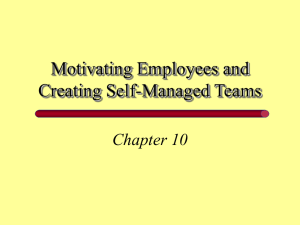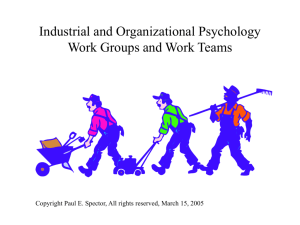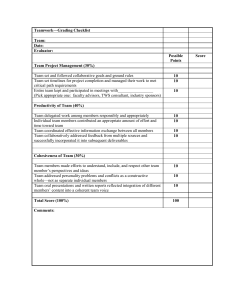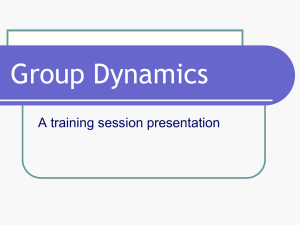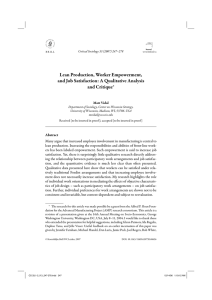Motivating Employees and Creating Self
advertisement
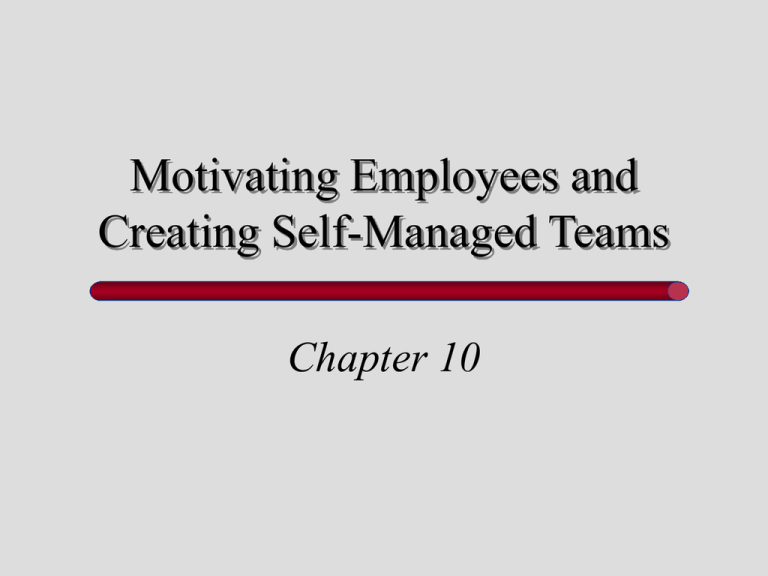
Motivating Employees and Creating Self-Managed Teams Chapter 10 I. Evolution of Motivation Theory A. Scientific Management 1. Develop a scientific approach for each element of a job 2. Scientifically selecting and training workers 3. Match individuals to well-suited tasks and responsibilities B. Hawthorne Studies/Hawthorne effect attention, caring, observation = productivity C. Maslow’s Hierarchy of Needs humans satisfy needs and are motivated to fulfill higher-level needs Self-actualization needs Esteem needs Social needs Safety needs Physiological needs D. Theories of Human Motivation 1. Theory X- people dislike work, people need to be controlled & threatened, people avoid responsibility 2. Theory Y- work is as natural as play, people respond to positive incentives, people enjoy responsibility & like to solve problems 3. Theory Z - employees participate in goal setting, problem solving, decision making, designing and implementing changes. Motivation is increased because workers feel appreciated. E. Herzberg’s Motivator-Hygiene Theory Motivating factors: intrinsic job elements that lead to worker satisfaction (e.g. achievement, recognition, advancement, responsibility) Hygiene factors: extrinsic elements of the work environment that, if not managed well, lead to worker dissatisfaction (e.g. salary, job security, working conditions, company policies) II. Contemporary Motivation Theories A. Expectancy Theory 1. Employees expect that the amount of effort leads to a certain performance level. 2. Employees expect that their performance level leads to certain outcomes 3. Employees expect the outcome will satisfy their personal needs. (employees expect something in return for their efforts) B. Equity Theory - Worker satisfaction is influenced by employees’ perceptions about how fairly they are treated compared with their co-workers. Pay should be proportional to the employee’s contribution to the firm. 1. Upward social comparison: comparing oneself to another who is better off on a particular attribute frequently results in decreased satisfaction 2. Downward social comparison: comparing oneself to another who is worse off on a particular attribute frequently results in increased satisfaction C. Goal-Setting Theory - an individual’s intention to work toward a goal is a primary source of motivation. Three integral components of goal-setting theory: -goals must be specific -goals must be challenging (not too easy/hard) -must provide feedback on employee progress toward goal III. Applying Motivation Theory A. Motivational job design 1. job enlargement ( no. & variety of tasks) 2. job enrichment (more autonomy, responsibility, authority) 3. job rotation (shift from one job to another) B. Work scheduling options 1. Compressed workweek (4/10) 2. Flextime (start/stop times vary) 3. Job sharing (a job shared by 2 workers) 4. Telecommuting C. Economic incentives -bonus, merit increases, addt’l vacation, addt’l benefits, etc. D. Non-economic incentives 1. Verbal praise 2. Recognition 3. Empowerment 4. Given new tasks 5. Asked to work on special projects and/or assignments IV. Using Teams A. Understanding Group Behavior 1. Group cohesiveness - the degree to which group members want to stay in the group and tend to resist outside influences a. Interpersonal cohesiveness: strong bonds & liking between people b. Task cohesiveness: strong commitment to the group task among members B. Types of Teams 1. Problem-solving • Employees from same department, area of expertise, and level of hierarchy • Meet to share information and discuss ways to improve processes and procedures in specific functional areas 2. Cross-functional • Employees of same hierarchical level but different functional areas of the organization • Allows people with various areas of expertise to pool resources, develop new ideas, solve problems, coordinate complex projects 3. Virtual team • Employees from different geographic or organizational locations that use a combination of telecommunications and information technologies to come together • Work together to accomplish a common goal but rarely meet face-to-face C. Pros and Cons of Teams Pros: Cons: • more information & knowledge • can generate more alternatives • often higher-quality decisions • group participation increases acceptance of solutions • take longer to reach solution • group may be dominated by a few individuals • lack of accountability • inequitable participation • a member taking credit for someone else’s ideas • personality conflicts may hinder productivity
